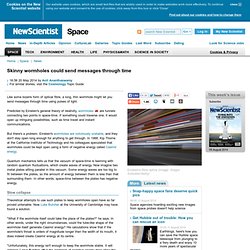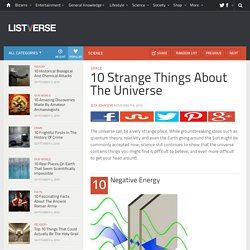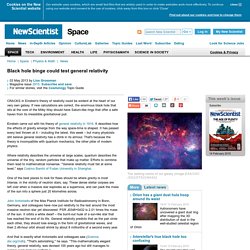

Skinny wormholes could send messages through time - space - 20 May 2014. Like some bizarre form of optical fibre, a long, thin wormhole might let you send messages through time using pulses of light.

Predicted by Einstein's general theory of relativity, wormholes are tunnels connecting two points in space-time. If something could traverse one, it would open up intriguing possibilities, such as time travel and instant communications. But there's a problem: Einstein's wormholes are notoriously unstable, and they don't stay open long enough for anything to get through. In 1988, Kip Thorne at the California Institute of Technology and his colleagues speculated that wormholes could be kept open using a form of negative energy called Casimir energy. Quantum mechanics tells us that the vacuum of space-time is teeming with random quantum fluctuations, which create waves of energy.
Slow collapse Theoretical attempts to use such plates to keep wormholes open have so far proved untenable. "What if the wormhole itself could take the place of the plates? " Harvard and MIT Scientists Create New State of Matter. The discovery, Lukin said, runs contrary to decades of accepted wisdom about the nature of light.

Photons have long been described as massless particles which don't interact with each other -- shine two laser beams at each other, he said, and they simply pass through one another. "Photonic molecules," however, behave less like traditional lasers and more like something you might find in science fiction -- the light saber. "It's not an in-apt analogy to compare this to light sabers," Lukin added. "When these photons interact with each other, they're pushing against and deflect each other. The physics of what's happening in these molecules is similar to what we see in the movies. " Researchers began by pumped rubidium atoms into a vacuum chamber, then used lasers to cool the cloud of atoms to just a few degrees above absolute zero.
As the photons enter the cloud of cold atoms, Lukin said, its energy excites atoms along its path, causing the photon to slow dramatically. Is missing 'partial' neutrino a boson in disguise? - physics-math - 27 June 2013. A particle proposed 50 years ago may be masquerading as a fraction of a neutrino.

If so, it could help to explain the origins of dark matter, the mysterious, invisible stuff that makes up more than 80 per cent of the universe's matter. Proposed in the 1960s, the Goldstone boson is supposed to be part of the Higgs mechanism, which gives mass to some other fundamental particles. But no hints of it have been seen in nature so far. Enter the cosmic microwave background (CMB), relic radiation from about 380,000 years after the big bang. Light Stopped For Minute By German Researchers In Record-Breaking Study. Albert Einstein postulated that nothing is faster than the speed of light.

But what if light was stopped dead in its tracks for, say, a minute? Impossible, right? Think again. Researchers at the University of Darmstadt in Germany achieved an incredible feat when they stopped light for an entire minute inside a crystal. In a paper about their research, published this month in the journal Physical Review Letters, the scientists explain how they stopped the light using a technique called electromagnetically induced transparency. Particle puzzle: Honey, I shrunk the proton - physics-math - 22 July 2013.
The 6 Most WTF Scientific Theories About Existence. 10 Strange Things About The Universe. Space The universe can be a very strange place.

While groundbreaking ideas such as quantum theory, relativity and even the Earth going around the Sun might be commonly accepted now, science still continues to show that the universe contains things you might find it difficult to believe, and even more difficult to get your head around. Theoretically, the lowest temperature that can be achieved is absolute zero, exactly ? 273.15°C, where the motion of all particles stops completely. However, you can never actually cool something to this temperature because, in quantum mechanics, every particle has a minimum energy, called “zero-point energy,” which you cannot get below. Black hole binge could test general relativity - space - 03 May 2013. CRACKS in Einstein's theory of relativity could be evident at the heart of our very own galaxy.

If new calculations are correct, the enormous black hole that sits at the core of the Milky Way should have Saturn-like rings that offer a safe haven from its irresistible gravitational pull. Einstein came out with his theory of general relativity in 1916. It describes how the effects of gravity emerge from the way space-time is shaped. It has passed every test thrown at it – including the latest, this week – but many physicists still believe general relativity has a chink in its armour. That's because the theory is incompatible with quantum mechanics, the other pillar of modern physics. Warp Drive More Possible Than Thought, Scientists Say. HOUSTON — A warp drive to achieve faster-than-light travel — a concept popularized in television's Star Trek — may not be as unrealistic as once thought, scientists say.

A warp drive would manipulate space-time itself to move a starship, taking advantage of a loophole in the laws of physics that prevent anything from moving faster than light. A concept for a real-life warp drive was suggested in 1994 by Mexican physicist Miguel Alcubierre; however, subsequent calculations found that such a device would require prohibitive amounts of energy. Now physicists say that adjustments can be made to the proposed warp drive that would enable it to run on significantly less energy, potentially bringing the idea back from the realm of science fiction into science.
"There is hope," Harold "Sonny" White of NASA's Johnson Space Center said here Friday (Sept. 14) at the 100 Year Starship Symposium, a meeting to discuss the challenges of interstellar spaceflight. Warping space-time Laboratory tests. Strange Particles May Travel Faster Than Light, Breaking Law of Physics. This story was updated at 6:20 p.m.

EDT. Nothing goes faster than the speed of light. At least, we didn't think so. New results from the CERN laboratory in Switzerland seem to break this cardinal rule of physics, calling into question one of the most trusted laws discovered by Albert Einstein. What is the Holographic Principle? Theorist Peter Higgs lives to see his boson - Technology & science - Science.